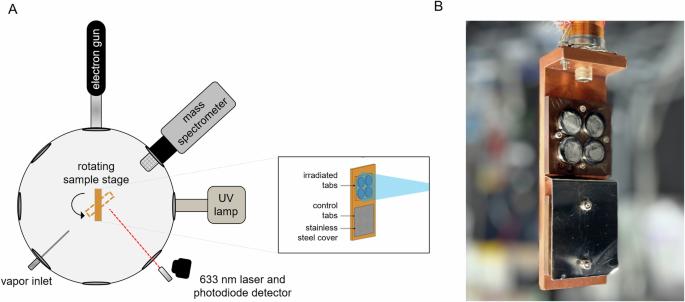细菌孢子形态在暴露于模拟的恩克拉多斯和欧罗巴表面条件后仍具有很高的可识别性
IF 8.9
1区 地球科学
Q1 ENVIRONMENTAL SCIENCES
引用次数: 0
摘要
恩克拉多斯和木卫二的地表下海洋被认为是寻找地球以外生命的最佳候选环境。从现实情况来看,旨在这些星球上寻找生命的首批任务很可能仅限于浅层次表层。在这里,我们研究了沉积在地表附近的生命迹象或生物特征是否能持续足够长的时间以被探测到,因为那里极端恶劣的条件往往会使它们降解。我们将枯草芽孢杆菌孢子暴露在海洋世界的表面条件下,并使用电子显微镜结合光谱学方法来评估孢子结构和形态生物特征的保存潜力。我们的研究结果表明,在极端条件下,孢子结构在失活很长时间后仍具有很强的复原力,这表明针对细胞形态的方法将成为未来海洋世界任务中生命探测策略的重要组成部分。在代表欧罗巴和土卫二表面的辐射和温度条件下进行的实验表明,尽管丧失了活力,细菌孢子的结构和形态仍然完好无损。本文章由计算机程序翻译,如有差异,请以英文原文为准。

Bacterial spore morphology remains highly recognizable after exposure to simulated Enceladus and Europa surface conditions
The subsurface oceans of Enceladus and Europa are thought to be some of the best candidate environments for finding life beyond Earth. Realistically, the first missions aimed at searching for life on these worlds will likely be restricted to the shallow subsurface. Here, we investigated whether indicators of life, or biosignatures, deposited near the surface could persist long enough to be detected, given that the extremely harsh conditions there would tend to degrade them. We exposed Bacillus subtilis spores to Ocean World surface conditions and used electron microscopy combined with spectroscopic approaches to assess the preservation potential of structural and morphological biosignatures derived from spores. Our results show that spore structure is highly resilient in the face of extreme conditions long after they have been inactivated, suggesting that methods targeting cell morphology would be valuable components in a suite of life detection strategies used in future missions to Ocean Worlds. Experiments conducted at radiation and temperature conditions representative of the surfaces of Europa and Enceladus suggest the structure and morphology of bacterial spores remain intact despite loss of viability
求助全文
通过发布文献求助,成功后即可免费获取论文全文。
去求助
来源期刊

Communications Earth & Environment
Earth and Planetary Sciences-General Earth and Planetary Sciences
CiteScore
8.60
自引率
2.50%
发文量
269
审稿时长
26 weeks
期刊介绍:
Communications Earth & Environment is an open access journal from Nature Portfolio publishing high-quality research, reviews and commentary in all areas of the Earth, environmental and planetary sciences. Research papers published by the journal represent significant advances that bring new insight to a specialized area in Earth science, planetary science or environmental science.
Communications Earth & Environment has a 2-year impact factor of 7.9 (2022 Journal Citation Reports®). Articles published in the journal in 2022 were downloaded 1,412,858 times. Median time from submission to the first editorial decision is 8 days.
 求助内容:
求助内容: 应助结果提醒方式:
应助结果提醒方式:


